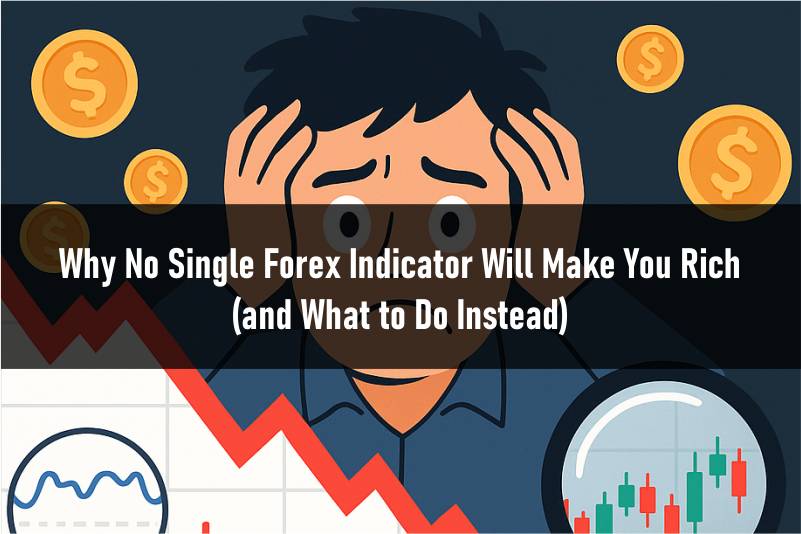
If you’ve been in the forex trading world for even a few weeks, you’ve probably seen ads or YouTube videos promising the best forex indicator — the one that supposedly predicts market moves with near-perfect accuracy. It’s tempting, isn’t it? The idea of loading a single tool on your chart and letting it guide every trade sounds like the shortcut to riches we all want.
But here’s the reality: no single forex indicator will make you rich.
Many traders learn this lesson the hard way — blowing accounts, jumping from one “holy grail” tool to the next, and wondering why nothing works consistently. The truth is that indicators are just tools, and like any tool, they need to be used in context, alongside others, and within a solid trading plan.
In this article, we’ll explore why single indicators fail, reveal the limitations of popular tools, and most importantly, show you what to do instead if you’re serious about becoming a profitable trader.
Why Traders Love the Idea of a Single Magic Indicator
Let’s be honest — the attraction is emotional as much as it is logical.
- Convenience & Simplicity: Learning multiple indicators, chart patterns, and market contexts can be overwhelming. A single “magic” tool feels like a way to skip the learning curve.
- The Dream of Effortless Profits: Many beginners equate success with automation — something that works while they sleep.
- Avoiding Complexity: Forex can be intimidating. One indicator promises clarity and removes the feeling of being overwhelmed.
The problem? This mindset often leads to overconfidence. When you trust one tool too much, you stop questioning its signals, ignore market changes, and take trades blindly — a recipe for losses.
The Limitations of Relying on One Forex Indicator
1. Accuracy Issues
No forex indicator is right 100% of the time. Every tool is built on historical data, which means it reacts to price movements — and the market doesn’t always behave the same way twice.
2. Market Conditions Change
An indicator that performs brilliantly in a trending market can fall apart in a ranging market. For example, a moving average crossover might give great entries when the market is moving strongly in one direction, but in choppy markets, it produces constant whipsaws.
3. False Signals & Whipsaws
Single indicators often give premature buy or sell signals. Without confirmation from other tools, you might enter a trade just before the market reverses — the dreaded “false breakout” scenario.
4. Lagging vs Leading Problems
- Lagging indicators (like Moving Averages and MACD) confirm trends but react slowly, causing late entries.
- Leading indicators (like RSI or Stochastic) try to predict reversals but often give signals too early.
Either way, using just one type exposes you to missed opportunities or unnecessary losses.
Examples of Popular Forex Indicators (and Their Weaknesses)
RSI (Relative Strength Index)
- Strength: Excellent for spotting overbought and oversold conditions.
- Weakness: In strong trending markets, RSI can stay overbought or oversold for extended periods, causing traders to exit winning trades too early or enter losing countertrend trades.
MACD (Moving Average Convergence Divergence)
- Strength: Helps identify the strength and direction of a trend.
- Weakness: As a lagging indicator, it can signal entry after most of the move has already happened, especially in fast-moving markets.
Bollinger Bands
- Strength: Great for visualizing volatility and spotting price breakouts or contractions.
- Weakness: In sideways markets, prices may “walk the band” without meaningful reversals, tricking traders into premature trades.
Each of these indicators is powerful in the right context — but dangerous if relied on alone.
Why Successful Traders Combine Indicators
The best traders know that no single indicator is a crystal ball. Instead, they use confluence — multiple tools pointing to the same conclusion — to improve accuracy and reduce risk.
For example:
- Trend Indicator: Moving Averages to confirm the market direction.
- Momentum Indicator: RSI to check if momentum supports the trade.
- Volume or Volatility Tool: Bollinger Bands or Volume Profile to validate the strength of the move.
By combining tools from different categories, you filter out bad trades and increase the odds of success. This is why the most profitable trading strategies aren’t built on one magic formula — they’re a balanced system.
What to Do Instead: Building a Reliable Trading System
1. Multi-Indicator Approach
A solid trading system blends tools that complement each other. A simple yet effective example:
- Trend Confirmation: 50-period EMA.
- Momentum Check: RSI (14) for overbought/oversold signals.
- Entry Timing: MACD crossover or candlestick pattern.
This approach ensures you’re trading with the trend, in line with momentum, and with precise entry timing.
2. Backtesting and Demo Trading
Before risking real money, backtest your strategy on historical data. This builds confidence and helps fine-tune settings. Then, test in a demo account to simulate live market conditions without financial risk.
3. Understanding Market Context
Indicators are only one part of the puzzle. The market is influenced by fundamental factors like interest rates, economic data, and geopolitical events. Combining technical indicators with a solid grasp of fundamentals puts you ahead of 90% of retail traders.
Common Mistakes to Avoid When Using Indicators
- Overcomplicating Your Charts: Too many indicators create “analysis paralysis” and conflicting signals. Stick to a small, complementary set.
- Ignoring Risk Management: Even the best system fails sometimes. Use stop-losses, manage position size, and never risk more than you can afford to lose.
- Trading Without a Plan: Jumping into trades on gut feeling, even with indicators on the chart, is gambling — not trading.
Conclusion: The Truth About Forex Indicators
No matter how convincing an ad, a YouTube guru, or a trading forum post sounds, no single forex indicator will make you rich. Success in forex comes from a well-rounded strategy that blends multiple indicators, market context, and disciplined risk management.
Indicators are tools, not magic wands. The real edge comes from how you use them together, how you adapt to changing market conditions, and how well you manage your risk.
If you’ve been chasing the “perfect” indicator, it’s time to stop and start building a system that works for you. Test it, refine it, and trade it consistently — that’s the real path to forex profits.





